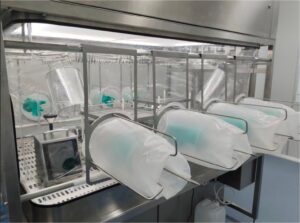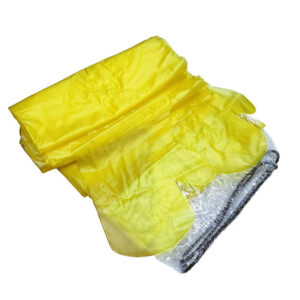Cleanroom environments demand exceptional precision, where even microscopic deviations can compromise product quality and regulatory compliance. The challenge facing facility managers and quality control professionals is establishing comprehensive equipment performance monitoring systems that provide real-time insights while maintaining operational efficiency. Without proper performance metrics, organizations risk costly production failures, regulatory violations, and compromised product integrity that can devastate both reputation and bottom line.
The consequences extend beyond immediate operational concerns. Inadequate performance monitoring leads to unexpected equipment failures, resulting in costly downtime and potential product contamination. Regulatory agencies increasingly scrutinize cleanroom operations, making robust performance documentation not just beneficial but mandatory for compliance.
This comprehensive guide provides actionable frameworks for implementing effective cleanroom equipment performance metrics, covering everything from fundamental monitoring principles to advanced predictive analytics. We’ll explore proven methodologies, industry benchmarks, and practical solutions that transform reactive maintenance into proactive quality assurance.
YOUTH Clean Tech has been at the forefront of cleanroom technology innovation, helping organizations worldwide achieve optimal performance standards through advanced monitoring and control systems.
What Are Essential Cleanroom Equipment Performance Metrics?
Core Performance Indicators
Cleanroom equipment performance encompasses multiple interconnected metrics that collectively ensure environmental control and product quality. The most critical indicators include airflow velocity consistency, particle count stability, and energy efficiency ratios. Industry standards typically require airflow velocity variations within ±15% of setpoint values, while particle counts must remain below specified thresholds for extended periods.
Filter efficiency represents another crucial metric, with HEPA filters requiring minimum 99.97% efficiency for 0.3-micron particles. In our experience, facilities achieving consistent 99.99% efficiency often demonstrate superior overall performance across all metrics. Temperature and humidity stability metrics typically target ±2°C and ±5% RH respectively, though specific requirements vary by industry application.
Pressure differential monitoring ensures proper containment, with typical specifications requiring 12.5-15 Pa minimum differential between adjacent areas. These foundational metrics create the baseline for comprehensive performance evaluation.
Advanced Monitoring Parameters
Modern cleanroom facilities increasingly adopt sophisticated monitoring approaches that extend beyond basic environmental parameters. Vibration analysis of critical equipment provides early warning indicators of mechanical issues, while power quality monitoring identifies electrical anomalies that could affect sensitive equipment operation.
Real-time contamination monitoring through particle counters and microbial samplers offers continuous validation of cleanroom performance. According to recent FDA guidance documents, continuous monitoring systems provide superior contamination detection compared to traditional periodic sampling methods.
| Performance Metric | Target Range | Monitoring Frequency |
|---|---|---|
| Airflow Velocity | ±15% setpoint | Continuous |
| Particle Count | <Class limit | Real-time |
| Filter Efficiency | >99.97% | Quarterly |
| Pressure Differential | 12.5-15 Pa | Continuous |
How Do You Establish Equipment Quality Control Standards?
Regulatory Framework Integration
Equipment quality control standards must align with applicable regulatory requirements while accommodating operational realities. ISO 14644 series provides fundamental guidelines, while industry-specific standards like FDA cGMP or EU GMP add additional layers of compliance requirements. The key lies in translating these broad regulatory concepts into specific, measurable performance criteria.
Validation protocols form the cornerstone of quality control standards, establishing documented evidence that equipment consistently operates within predetermined parameters. As industry expert Dr. Sarah Mitchell notes, “Successful validation programs focus on critical attributes that directly impact product quality rather than documenting every possible parameter.”
Risk-based approaches help prioritize monitoring efforts, focusing resources on equipment and parameters with highest potential impact on product quality. This strategy proves particularly valuable for complex facilities with hundreds of monitored points.
Documentation and Traceability Systems
Comprehensive documentation systems enable effective quality control by providing historical performance data and trend analysis capabilities. Electronic batch records and automated data logging systems reduce human error while improving data integrity and regulatory compliance.
Change control procedures ensure that equipment modifications undergo proper evaluation and validation before implementation. A 2023 study by the International Society for Pharmaceutical Engineering showed that facilities with robust change control procedures experienced 40% fewer quality incidents compared to those with informal processes.
What Equipment Monitoring Technologies Deliver Optimal Results?
Real-Time Monitoring Solutions
Modern equipment monitoring technologies leverage Internet of Things (IoT) sensors and cloud-based analytics to provide unprecedented visibility into cleanroom performance. Wireless sensor networks eliminate installation complexity while providing comprehensive coverage of critical parameters.
Smart sensors with built-in calibration capabilities reduce maintenance overhead while ensuring measurement accuracy. These systems typically feature self-diagnostic capabilities that alert operators to potential sensor issues before they compromise data quality. In our experience, facilities implementing smart sensor networks achieve 25-30% reduction in calibration-related maintenance costs.
Predictive analytics algorithms analyze historical performance data to identify emerging trends and potential issues before they result in equipment failures or environmental excursions. Machine learning models continuously improve prediction accuracy by incorporating operational patterns and external factors.
Integration and Automation Strategies
Centralized monitoring platforms integrate data from multiple equipment types and locations, providing comprehensive facility oversight through unified dashboards. These systems enable rapid response to emerging issues while maintaining detailed historical records for regulatory compliance.
Automated alarm systems with intelligent escalation procedures ensure appropriate personnel receive timely notifications based on incident severity and operational context. Advanced systems incorporate shift schedules and personnel locations to optimize response coordination.
While these technologies offer significant benefits, implementation complexity and initial costs can present challenges for smaller facilities. However, the long-term benefits of reduced compliance risk and improved operational efficiency typically justify the investment within 2-3 years.
Mobile and Remote Monitoring Capabilities
Mobile applications enable facility personnel to access real-time performance data and receive critical alerts regardless of location. This capability proves particularly valuable for multi-site operations and emergency response scenarios.
Remote monitoring capabilities allow equipment manufacturers and service providers to proactively identify potential issues and coordinate maintenance activities. A pharmaceutical facility in Switzerland reported 35% reduction in unplanned downtime after implementing remote monitoring for critical HVAC equipment.
How Can Performance Testing Optimize Equipment Efficiency?
Systematic Testing Methodologies
Performance testing protocols must balance thoroughness with operational practicality to deliver meaningful insights without disrupting production schedules. Challenge testing using standardized procedures validates equipment performance under various operational conditions, including worst-case scenarios that might occur during actual production.
Smoke pattern visualization provides qualitative assessment of airflow patterns and potential contamination pathways. While quantitative measurements remain primary validation tools, visual confirmation helps identify issues that numerical data might miss. Industry consensus suggests combining both approaches for comprehensive equipment evaluation.
Periodic retesting schedules ensure continued compliance with performance specifications. The frequency depends on equipment criticality, regulatory requirements, and historical performance data. Critical equipment typically requires quarterly testing, while less critical systems might undergo annual evaluation.
Data Analysis and Interpretation
Statistical process control techniques help distinguish between normal variation and meaningful performance changes. Control charts and trend analysis identify gradual degradation that might otherwise go unnoticed until significant problems develop.
Correlation analysis between different performance parameters often reveals insights not apparent from individual measurements. For example, slight increases in particle counts might correlate with specific temperature or humidity conditions, suggesting optimization opportunities.
| Testing Parameter | Acceptance Criteria | Test Method |
|---|---|---|
| Airflow Uniformity | ±20% average | Anemometer grid |
| Recovery Time | <15 minutes | Particle injection |
| Containment | No migration | Tracer gas |
What Role Does Cleanroom Equipment Metrics Play in Compliance?
Regulatory Compliance Framework
Cleanroom equipment metrics serve as objective evidence of facility compliance with applicable regulations and standards. Regulatory agencies increasingly expect facilities to demonstrate continuous compliance through comprehensive monitoring data rather than relying solely on periodic testing.
FDA’s Quality by Design initiative emphasizes understanding and controlling process variables that impact product quality. Equipment performance metrics provide the foundation for this understanding by documenting how environmental conditions affect manufacturing processes.
Audit readiness depends heavily on the quality and completeness of performance documentation. Facilities with robust metrics collection and analysis systems consistently receive favorable audit outcomes compared to those with minimal documentation.
Risk Management Integration
Quality risk management principles help prioritize monitoring efforts based on potential impact on product quality and patient safety. High-risk areas require more intensive monitoring, while lower-risk zones might use simplified approaches.
Trending analysis of equipment metrics enables proactive risk mitigation by identifying performance degradation before it reaches critical levels. A semiconductor facility in Taiwan prevented a potential contamination event by detecting subtle changes in particle count trends three weeks before conditions would have exceeded specification limits.
How Do You Implement Continuous Equipment Performance Improvement?
Performance Benchmarking Strategies
Establishing performance benchmarks requires careful analysis of historical data, industry standards, and operational requirements. Best-in-class facilities typically achieve particle count performance 50-75% better than minimum regulatory requirements, providing substantial safety margins for process variations.
Comparative analysis against industry benchmarks identifies improvement opportunities and validates current performance levels. However, direct comparisons must account for differences in facility age, design, and operational requirements.
Internal benchmarking between similar equipment or areas within the same facility often provides more actionable insights than external comparisons. This approach eliminates variables related to different regulatory environments or operational philosophies.
Continuous Improvement Methodologies
Lean Six Sigma techniques applied to equipment performance management help identify and eliminate sources of variation and inefficiency. Process mapping reveals opportunities to streamline monitoring procedures while maintaining data quality and regulatory compliance.
Regular performance review meetings bring together operations, maintenance, and quality personnel to analyze trends and develop improvement strategies. These cross-functional teams often identify solutions that individual departments might miss.
It’s worth noting that continuous improvement efforts require sustained management commitment and resource allocation. Organizations sometimes struggle with maintaining momentum after initial improvements, particularly when competing priorities emerge.
For comprehensive equipment solutions that support continuous improvement initiatives, explore advanced cleanroom equipment designed for optimal performance monitoring and control.
What Challenges Affect Equipment Performance Measurement?
Technical and Operational Obstacles
Calibration complexity presents ongoing challenges for maintaining measurement accuracy across multiple sensor types and locations. Different sensors require varying calibration frequencies and procedures, creating logistical complexity for maintenance teams. Some specialized sensors may require calibration intervals as frequent as monthly, while others maintain accuracy for extended periods.
Data interpretation difficulties arise when multiple variables interact in complex ways. Environmental conditions, equipment age, operational procedures, and external factors all influence performance metrics simultaneously. Distinguishing between normal operational variation and meaningful performance changes requires sophisticated analysis capabilities.
Cost considerations often limit the extent of monitoring implementation, particularly for smaller facilities or those with limited budgets. Advanced monitoring systems require substantial initial investment plus ongoing maintenance and calibration expenses.
Integration and Compatibility Issues
Legacy equipment integration poses significant challenges when implementing comprehensive monitoring systems. Older equipment may lack modern communication interfaces, requiring costly retrofits or manual data collection procedures that introduce potential errors.
Different equipment manufacturers often use proprietary communication protocols that complicate system integration efforts. Achieving seamless data flow between disparate systems requires careful planning and potentially custom interface development.
What Future Trends Will Shape Performance Monitoring?
Emerging Technologies and Innovations
Artificial intelligence and machine learning applications continue expanding in equipment performance monitoring, offering predictive capabilities that surpass traditional statistical methods. These technologies can identify subtle patterns in complex datasets that human analysts might miss.
Digital twin technology creates virtual representations of cleanroom equipment that enable sophisticated modeling and optimization without disrupting actual operations. Early adopters report significant improvements in maintenance planning and performance optimization.
Blockchain technology offers potential solutions for data integrity and traceability challenges, particularly in highly regulated industries where documentation authenticity is critical. While still emerging, pilot programs show promising results for regulatory compliance applications.
Industry Evolution and Standards Development
Regulatory agencies continue evolving their expectations for continuous monitoring and real-time data analysis. Future regulations likely will require more sophisticated monitoring approaches than current minimum standards mandate.
Industry collaboration through organizations like ISPE and PDA helps establish best practices and standardized approaches to performance monitoring. These efforts reduce implementation complexity while improving overall industry performance.
Conclusion
Effective cleanroom equipment performance metrics form the foundation of successful contamination control and regulatory compliance. The integration of real-time monitoring technologies, systematic testing protocols, and comprehensive data analysis creates robust frameworks for maintaining optimal environmental conditions.
Key implementation strategies include establishing clear performance benchmarks aligned with regulatory requirements, implementing appropriate monitoring technologies matched to facility needs, and developing comprehensive documentation systems that support both operational decisions and compliance obligations. Organizations achieving superior performance consistently focus on preventive approaches rather than reactive problem-solving.
Moving forward, expect increasing emphasis on predictive analytics, automated monitoring systems, and integrated quality management approaches. Facilities that invest in comprehensive equipment performance monitoring systems today will be better positioned to meet evolving regulatory expectations while maintaining operational efficiency.
The next steps involve assessing current monitoring capabilities against industry best practices, identifying critical performance gaps, and developing implementation roadmaps that balance compliance requirements with operational realities. Whether upgrading existing systems or implementing new monitoring programs, success depends on sustained commitment to continuous improvement and data-driven decision making.
How will your facility adapt its performance monitoring approach to meet tomorrow’s challenges while maintaining today’s operational excellence? The answer lies in thoughtful integration of proven methodologies with emerging technologies, supported by comprehensive cleanroom equipment solutions designed for long-term performance and reliability.
Frequently Asked Questions
Q: What are the key performance metrics for cleanroom equipment in quality control?
A: Key performance metrics for cleanroom equipment include air quality, temperature and humidity control, airflow and pressure differentials, and filtration efficiency. These metrics are crucial for ensuring that the cleanroom operates within specified standards, maintaining a controlled environment that minimizes contamination risks.
Q: How do cleanroom equipment performance metrics contribute to quality control?
A: Cleanroom equipment performance metrics are essential for quality control as they help in maintaining the required cleanliness levels, ensuring product sterility, and meeting regulatory standards. By monitoring these metrics, facilities can ensure operational consistency and compliance with industry standards, thereby enhancing product safety and quality.
Q: What role does installation qualification (IQ) play in ensuring cleanroom equipment performance?
A: Installation qualification (IQ) is vital as it verifies that all cleanroom equipment is installed correctly according to specifications. It includes testing the supply air quality, HVAC calibration, and HEPA filter integrity, ensuring that the cleanroom environment is properly set up before operational tests begin.
Q: What are the main differences between operational qualification (OQ) and performance qualification (PQ)?
A: Operational qualification (OQ) assesses whether the cleanroom operates as intended under simulated conditions, focusing on tests like airflow, temperature, and humidity. Performance qualification (PQ), on the other hand, evaluates the cleanroom while it is in operation, ensuring that it maintains the required cleanliness standards and performance metrics during actual use.
Q: How often should cleanroom equipment be maintained to ensure optimal performance?
A: Cleanroom equipment should be regularly inspected and maintained based on industry standards and the type of cleanroom. For example, ISO class 1 equipment typically requires more frequent maintenance compared to ISO class 7. Regular calibration of tools and machinery is also essential to ensure accuracy and reliability of operations. Maintenance intervals may vary depending on usage and environmental conditions within the cleanroom.
External Resources
- CQV: 5 Key Metrics for Monitoring Cleanroom Hygiene – Incepbio – Explores five critical metrics for monitoring cleanroom hygiene and provides actionable insights for maintaining quality control and compliance during the Commissioning, Qualification, and Validation (CQV) process.
- Cleanrooms Performance Qualification – GxP Cellators – Details the step-by-step process for cleanroom performance qualification, covering planning, documentation, testing, and reporting to ensure operational consistency and regulatory compliance.
- Cleanroom Qualification And Validation In GMP – Provides a comprehensive overview of cleanroom qualification and validation under GMP guidelines, including equipment testing, performance metrics, and continuous monitoring standards.
- Clean Room Classifications & ISO Standards – Outlines the ISO standards and classifications for cleanrooms, explaining associated performance metrics and requirements for maintaining specified particle counts.
- Cleanroom: A Comprehensive Guide to Design, Standards, and … – Offers an in-depth guide to cleanroom design, including essential standards, equipment considerations, and quality control measures for various industries.
- Cleanroom Validation: How to Manage Risk in Contamination Control – Discusses strategies and metrics for cleanroom validation, focusing on risk management and quality control to ensure contamination control in regulated environments.
Related Contents:
- Understanding Cleanroom Equipment Standards and Requirements
- Environmental Monitoring in Sterility Test Isolators
- GMP Compliant Cleanroom Equipment | FDA Requirements Guide
- ISO 14644 Cleanroom Equipment Standards | Compliance Guide
- LAF Garment Cabinet Performance Monitoring Tips
- 21 CFR Part 11 Compliance: Sterility Test Isolators
- Cleanroom Equipment Cost Analysis | ROI Calculator 2025
- FDA Approved Cleanroom Equipment | Regulatory Documentation
- Cleanroom Equipment Types | Classification | Selection Guide




























